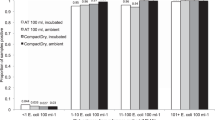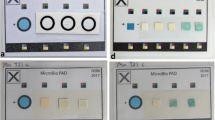Abstract
Methods for rapid detection of fecal indicator bacteria in water are important to ensure that water is safe for drinking, bathing, recreation, fishing and shellfish harvesting. In this study, we tested experimental conditions for bacterial hydrolysis of two promising enzymatic substrates, 5-Bromo-4-chloro-3-indolyl β-d-glucuronide (X-Gluc) and Resorufin β-d-glucuronide (REG), and optimized parameters such as temperature and pH to determine conditions for rapid reactions. We then innovated a membrane filter-based approach to facilitate more rapid enzyme-based detection of Escherichia coli in water based on the combination of an initial concentration step and optimized test conditions. For this approach, a water sample (10‒100 mL) is filtered through a 0.45-µm pore size filter with a diameter of 4 or 13 mm. After filtration, a newly designed rapid detection broth is added containing the enzymatic inducer Methyl-beta-d-Glucuronide sodium (MetGlu) and the substrate REG or X-Gluc. After a few (1‒7) hours of incubation at 35 °C, the filter shows pink color (for REG-containing broth) or green color (for X-Gluc containing broth) if E. coli is present. The study provides insights and approaches towards developing a simple, fast, and low-cost method to detect fecal indicator bacteria in water.



Similar content being viewed by others
References
Bain R, Cronk R, Wright J, Yang H, Slaymaker T, Bartram J (2014) Fecal contamination of drinking-water in low- and middle-income countries: a systematic review and meta-analysis. PLoS Med. https://doi.org/10.1371/journal.pmed.1001644
Pruss-Ustun A, Bartram J, Clasen T, Colford JM, Cumming O, Curtis V, Bonjour S, Dangour AD, De France J, Fewtrell L, Freeman MC, Gordon B, Hunter PR, Johnston RB, Mathers C, Mausezahl D, Medlicott K, Neira M, Stocks M, Wolf J, Cairncross S (2014) Burden of disease from inadequate water, sanitation and hygiene in low- and middle-income settings: a retrospective analysis of data from 145 countries. Trop Med Int Health 19(8):894–905. https://doi.org/10.1111/tmi.12329
Wu J, Long SC, Das D, Dorner SM (2011) Are microbial indicators and pathogens correlated? A statistical analysis of 40 years of research. J Water Health 9(2):265–278. https://doi.org/10.2166/wh.2011.117
USEPA (1989) National primary drinking water regulations: total coliform rule, final rule. Fed Regist 54 (124):27544–27568
Fewtrell L, Bartram J (2001) Water quality: guidelines, standards and health: assessment of risk management for water-related infectious disease. WHO water series. IWA Publishing, London
WHO (2011) Guidelines for drinking-water quality, 4th edn. WHO, Geneva
Rompre A, Servais P, Baudart J, de-Roubin MR, Laurent P (2002) Detection and enumeration of coliforms in drinking water: current methods and emerging approaches. J Microbiol Meth 49(1):31–54. https://doi.org/10.1016/S0167-7012(01)00351-7
Frahm E, Obst U (2003) Application of the fluorogenic probe technique (TaqMan PCR) to the detection of Enterococcus spp. and Escherichia coli in water samples. J Microbiol Methods 52(1):123–131
Kong R, Lee S, Law T, Law S, Wu R (2002) Rapid detection of six types of bacterial pathogens in marine waters by multiplex PCR. Water Res 36(11):2802–2812
Lee JY, Deininger RA (2004) Detection of E. coli in beach water within 1 hour using immunomagnetic separation and ATP bioluminescence. Luminescence 19(1):31–36. https://doi.org/10.1002/bio.753
Ruan JH, Wang WJ, Zhang TY, Bai QY, Zheng T, Zhang ZD, Wu LY, Huang YF, Yu DJ (2017) Rapid detection of Serratia fonticola by TaqMan quantitative real-time PCR using primers targeting the gyrB gene. Curr Microbiol 74(11):1343–1348
Noble R, Weisberg R (2005) A review of technologies for rapid detection of bacteria in recreational waters. J Water Health 3:381–392
Gunda NSK, Naicker S, Shinde S, Kimbahune S, Shrivastava S, Mitra S (2014) Mobile Water Kit (MWK): a smartphone compatible low-cost water monitoring system for rapid detection of total coliform and E. coli. Anal Methods UK 6(16):6236–6246. https://doi.org/10.1039/c4ay01245c
Hesari N, Alum A, Elzein M, Abbaszadegan M (2016) A biosensor platform for rapid detection of E. coli in drinking water. Enzyme Microb Technol 83:22–28. https://doi.org/10.1016/j.enzmictec.2015.11.007
Lederberg J (1950) The beta-d-galactosidase of Escherichia coli, strain K-12. J Bacteriol 60(4):381
Rice EW, Allen MJ, Edberg SC (1990) Efficacy of beta-glucuronidase assay for identification of Escherichia coli by the defined-substrate technology. Appl Environ Microb 56(5):1203–1205
Ley AN, Bowers RJ, Wolfe S (1988) Indoxyl-beta-D-glucuronide, a novel chromogenic reagent for the specific detection and enumeration of Escherichia coli in environmental-samples. Can J Microbiol 34(5):690–693
Olstadt J, Schauer JJ, Standridge J, Kluender S (2007) A comparison of ten USEPA approved total coliform/E. coli tests. J Water Health 5(2):267–282
Stauber C, Miller C, Cantrell B, Kroell K (2014) Evaluation of the compartment bag test for the detection of Escherichia coli in water. J Microbiol Methods 99:66–70. https://doi.org/10.1016/j.mimet.2014.02.008
Bain RES, Woodall C, Elliott J, Arnold BF, Tung R, Morley R, du Preez M, Bartram JK, Davis AP, Gundry SW, Pedley S (2015) Evaluation of an inexpensive growth medium for direct detection of Escherichia coli in temperate and sub-tropical waters. PLoS ONE. https://doi.org/10.1371/journal.pone.0140997
Magro G, Bain RES, Woodall CA, Matthews RL, Gundry SW, Davis AP (2014) Synthesis and application of resorufin beta-D-glucuronide, a low-cost chromogenic substrate for detecting Escherichia coli in drinking water. Environ Sci Technol 48(16):9624–9631. https://doi.org/10.1021/es502319n
Tryland I, Fiksdal L (1998) Enzyme characteristics of beta-D-galactosidase- and beta-D-glucuronidase-positive bacteria and their interference in rapid methods for detection of waterborne coliforms and Escherichia coli. Appl Environ Microb 64(3):1018–1023
Gallagher SR (1992) Quantitation of GUS activity by fluorometry. GUS protocols: using the GUS gene as a reporter of gene expression. Academic Press, San Diego, CA
Liang W-J, Wilson KJ, Xie H, Knol J, Suzuki SI, Rutherford NG, Henderson PJ, Jefferson RA (2005) The gusBC genes of Escherichia coli encode a glucuronide transport system. J Bacteriol 187(7):2377–2385
Togo CA, Wutor VC, Pletschke BI (2006) Properties of in situ Escherichia coli -D-glucuronidase (GUS): evaluation of chemical interference on the direct enzyme assay for faecal pollution detection in water. Afr J Biotechnol 5(22):2338–2344
Fior S, Vianelli A, Gerola PD (2009) A novel method for fluorometric continuous measurement of P-glucuronidase (GUS) activity using 4-methyl-umbelliferyl-beta-D-glucuronide (MUG) as substrate. Plant Sci 176(1):130–135. https://doi.org/10.1016/j.plantsci.2008.10.001
Acknowledgements
We would like to thank UNICEF (No. 43171142) and the North Carolina Sea Grant (No. 2014-1751-02) for financial support.
Author information
Authors and Affiliations
Corresponding author
Ethics declarations
Conflict of interest
The authors have no any conflict of interest with these awards. Jamie Bartram has served on UNICEF advisory committees unconnected to the subject of the award.
Rights and permissions
About this article
Cite this article
Wu, J., Stewart, J.R., Sobsey, M.D. et al. Rapid Detection of Escherichia coli in Water Using Sample Concentration and Optimized Enzymatic Hydrolysis of Chromogenic Substrates. Curr Microbiol 75, 827–834 (2018). https://doi.org/10.1007/s00284-018-1454-8
Received:
Accepted:
Published:
Issue Date:
DOI: https://doi.org/10.1007/s00284-018-1454-8




